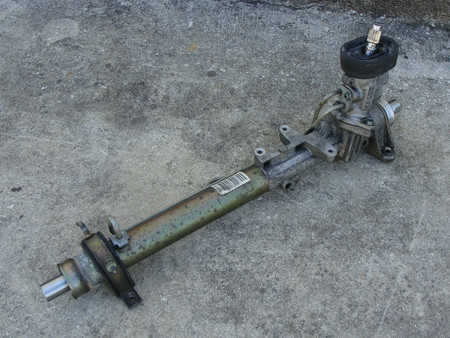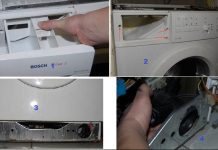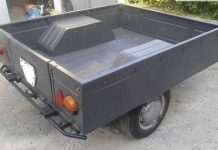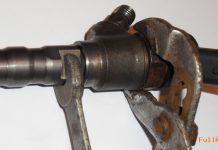In detail: do-it-yourself steering rack repair Skoda Octavia from a real master for the site my.housecope.com.
The information applies to the repair of vehicles with steering rack 1J1 422 105 DE:
Volkswagen Golf 4 / Volkswagen Golf 4 (1J1, 1J5) 1997 - 2004
Volkswagen Bora / Volkswagen Bora (1J2, 1J6) 1999 - 2005
Volkswagen New Beetle (1C1, 9C1, 1Y7) 1999 - 2002
Skoda Octavia A4 / Skoda Octavia A4 (1U2, 1U5) 1997 - 2010
SEAT Leon / Seat Leon (1M1) 1999 - 2006
SEAT Toledo Mk2 / Seat Toledo (1M2) 1998 - 2004
It all started with the fact that she snotty a little with the right edge. but I went and did not grunt, as it seemed to me. hit a little frost. bam and all the liquid has gone somewhere. bought a liter and I had enough work-home-work-garage. all
After arriving at the garage, the rail was removed by me, the rods were unscrewed. everything is cleaned and wiped, the dirt is removed, the hydraulic pipes are wrapped in a bag
At work, I disassembled the rail and found a lot of dirt in the rail. rusty shaft .. corrosion pits. working out in the right edge of the bushing
- remove the tube clamps from the cylinder body by a punch through a piece of wood and pliers;
- unscrew the 5-pipe stop bolt from the valve block with a hexagon;
- take out the tubes and gaskets;
- unscrew with a 5 hexagon the two bolts of the valve block;
- turning the block by hand, remove it up the steering shaft;
- under the splines of the shaft, carefully put on an open-end wrench for 15 and tap the steering shaft out of the rack with the bearing with a rubber hammer;
- carefully remove the rubber ring from the bearing;
- then turn off the nut of the shaft support with a 17-inch head .. such a round plug; I didn't succeed, I licked the edges. carefully drilled in on the outer diameter and unscrewed with a key from the grinder;
- pulling out the spring, gasket, cylinder with pasatizh, if it does not work, then you can pull it out later, the shaft is already weakened;
- further from the right end we clean out the dirt and there you will see a thin locking ring, remove it;
- we translate the shaft to the right to the end .. we knock and this plug will come out on the right;
- remove the rubber ring from it carefully;
The principle of the rake is disassembled)
| Video (click to play). |
- the oil seals are very tough. stocked up with screwdrivers with side cutters. we knock out the inner stuffing box of the plug, there is a ringlet in it .. it's not scary to break it. but do not break the bushing with the cut sides under the gland .. and do not split the plug itself to death.
- I advise you to stock up on a neat chisel with a width of about 1 cm - we slightly cut the bottom of the gland, it clumsy, pick from the sides. Hurray, the oil seal is removed ..
- with an internal oil seal, the affairs are worthless, it sits deeply .. IT IS IMPOSSIBLE TO HALF THE REIKU. I immediately say what happened - I found a strip of metal 5x10x400, sharpened it and used it as a long chisel. operation as with the first oil seal .. Be careful with the cylinder mirror)
That's it, now the rake has been dismantled for sure
Now the defect. I did not touch the valve block .. everything is dry, clean, the rubber bands are intact. (mileage 200000)
- the mirror of the rail - no scuffs and scratches, but there was a little bit of runtime in the ellipse in the middle position of the steering wheel .. well, and X on it.
- oil seals. only in the trash. the cage on the shaft piston - I was intact, and there was nothing to replace it with.
- to protect against damage, we wrap the piston and the steering shaft with electrical tape over the elastic bands and the second-layer ring.
Corrosion is to blame for everything, the shaft is pitted, the rough surface and backlash of the right edge completely killed the oil seal, the second also snotted.
Shaft measurements: about 23.98 mm piston. in the place of the middle rudder under the bushing of the right edge - 23.89
Further grinding. Do not use incisors.
Only emery cloth, on an elastic band, a plank. and gradually larger and larger numbers up to 2500. Further, the felt and the shaft shine like a mirror.
measurements showed part of the shaft - from the piston to the teeth 23.97. from the piston to the right shaft 23.88.
I draw your attention .. the right edge of the shaft should be sanded so that the working out from the sleeve is gone.
we sharpen the new sleeve from caproloctane.we sharpen it so that it goes with oil in the cork with little effort but evenly right up to the piston
The oil seals are expensive, they are somehow special, I am sure that it was possible to pick it up cheaper, but the oil seals cost me 300 UAH for two pieces
Dimensions (edit)
24x39x8.5
24x37x8.5
the oil seals are very hard
- crushed the oil seal into the plug with a plastic sleeve, which was pulled out of the rail cylinder from the large oil seal (Pick it up with a thin electrode and a screwdriver through the hole in the tube) .. press gently with a vice .. everything is pre-oiled.
with a long-distance large oil seals, things are more complicated. we put it from the side of the shaft teeth on the shaft with the right side with a plastic mandrel. insert the shaft into the rail, push the oil seal with the piston against the rail. the rail is pre-oiled.
insert the left edge of the shaft into the chuck of the lathe. the right edge of the shaft is carefully squeezed into the rail with the oil seal with the thrust headstock of a lathe with a screw drive. it turned out great. the gland mandrel will be positioned opposite the tube opening.
Wash the rail and the shaft thoroughly.
further assembly in reverse order:
- fill the cavity with grease through the hole for the stop plug or the releasing shaft (for example, for a constant velocity joint or special)
- tap the right plug through the mandrel down to the slot for the ring.
well, then everything is clear)
put the rail .. connected the hydraulic hoses. washers, if copper, I advise you to warm it up with a lighter, which were soft. flooded with slurry. started .. we turn the steering wheel right away, fill up the liquid. It is imperative to turn the steering wheel immediately.
so the mileage is already 40 km .. the liquid is in place.
About the assembly of the rail
- it is very important to maintain cleanliness: the less sand gets in, the longer the unit will last ... and the better your work will be ..
GUR:
the renovation was simpler here. even the last owner burst his back cover .. and how it is so incomprehensible. he sealed it with a thick layer of cold welding ..
dripping ..
I found a new (in the sense of a used cover from a dead pump) pump KYB .. but it was rubbed at the back, where the rotor rotates.
- surface grinding machine, lapping on fine emery, felt. the lid is ready
- I collected everything and put it in place
(we work together. you need a side head, good, wrenches and one adjustable wrench or gas, screwdriver)
so:
- we hang the front of the car higher from the pit, having previously ripped off the bolts of the front wheels;
- remove the wheels;
- for convenience (you can not do it), unscrew the nuts securing the CV joints to the hub (there is a large one in the center of the wheel) .. the assistant presses on the brake, you can start the engine so that the brakes are stronger (attention - sometimes a special head)
- unscrews the nuts of the hinges of the steering tips on both sides, press them out of the hubs;
- we unscrew three bolts of fastening the ball joints (if you use a special wedge puller, you can pull the ball out of the trunnions)
- unscrew the stabilizer rods from the levers
(pay attention to the position of the washers of the bolts of the subframe at the back .. it is necessary to install the subframe later as well - I had the rono in the center, I put it in the same way)
- unscrew the four bolts securing the rail to the subframe from the bottom (like 16)
- we take out the ball from the levers by moving the hub to the sides of the engine compartment;
- unscrew the lower cushion from the engine;
- unscrew the stretcher from the car. let the assistant hold it, sometimes you need a decent extension cord in the form of a pipe on the knob to rip it off;
- starts the stabilizer by the CV joints. lower the stretcher and carry it to the side
- pre-drain the fluid from the supply hose into the power steering pump. we unscrew the hydraulic lines from the rail with a head at 19 and 22 or 16 and 19 with a ratchet conveniently;
- all ends of the hydraulic pipelines should be wrapped in polyethylene to prevent dirt from getting in, and before unscrewing them, it is worth wiping the joints off the dirt;
- remove the plastic protection on the legs of the driver, unscrew the bolt on the cardan by 13
- unscrew the three bolts for fastening the tubes and aluminum protection from the top of the rail;
- shaking by pulling the rail down, and the assistant helps her to get out of the joint in the cabin with a screwdriver;
- we carry the rail with rods to the side;
first remove the boot of the left wheel traction;
- we hold the shaft with an open-end wrench for the slot, with a butt or an adjustable one, unscrew the rod from the rail;
- we repeat unscrewing the thrust from the opposite side, we hold the shaft as in the first time;
Attention:
we tighten the bolts of the rail fastening with a torque wrench when collapsing, they are easy to rip off, like 25 Nm. the second stage is 90 degrees .. to refine the nano in the manual
subframe bolts - 100 Nm, then 90 degrees
I'll tell you a secret that before this photo session, the rake was already disassembled, cleaned, assembled and ready for action. So here it is, the removed rail from the car:
The rail was removed, the rods were unscrewed (it is possible also by the car), the anthers were removed, they were thoroughly wiped off, the oil was drained from it as much as possible, the shaft was moved back and forth. washed the rail thoroughly
Next, unscrew the nut, which they like to call the adjusting nut:
It turns out that everything is not so scary!
Simply, those who are engaged in the repair of steering racks do not say a lot, but by and large profit from other people's problems. In short, you need a bearing, its price is from 150 to 275 rubles and a good turner.
The material that I used, a bronze-graphite bushing, from some kind of agricultural equipment, I don't know for sure.
Price RUB 95
In principle, caprolon can be used.
Set the steering wheel straight and, for correctness, mark it with a marker at the junction of the cardan with the rack shaft.
Remove the rail.
Unscrew the adjusting washer from the shaft side, unscrew the lower bearing cap, unscrew the nut that holds the bearing itself, remove the plastic boot and very carefully pull out the shaft, marking its position.
Having previously released the shaft from the connector ..
Then knock out the bearing and knock out the sleeve through the bottom, which is located in the upper part, in fact, this sleeve and yavl. cause of knocking.
But the bearing also had a backlash, I replaced it.
In principle, you can replace the sleeve that is in the reservoir. lid, I didn’t.
The factory shaft sleeve is made of aluminum with a sputtering reminiscent of vtoroplast, its outer size is 30 inner 26mm, the bearing is made in Indonesia, brand 3601, in my opinion.
The most important thing, do not damage the cable, which is located in the shaft housing.
Having removed the shaft, it is better to fix it in one position, there is a retainer on it.
Plus, I additionally sealed it with tape.
note, when you remove the connector from the shaft, in what position it stood, there is a slot on the white case into which the connector enters, it is important.
Steering is not only a functional vehicle system, but also a system directly related to driving safety. Its key component is the steering rack, which is found on most modern cars. The steering rack of the Skoda Octavia Tour has a finite resource, which is reduced due to poor-quality road surface and the lack of correct preventive maintenance by the car owner. Anyone can potentially approach the issue of repairing or replacing a rail, so it is useful to get acquainted with some advice from professional specialists of our car service.
Any driver, regardless of driving experience, must accurately determine the malfunction of the steering rack by external signs, so as not to direct senseless efforts and costs in a knowingly false direction.
- Power steering fluid leak
Even if it was not possible to notice in time a drop in the liquid level in the expansion tank or a suspicious oily spot under the car while it was parked, the characteristic buzzing sound of the power steering pump, amplified by the rotation of the steering wheel, indicates that air is starting to enter the pump. While the driver is analyzing the current situation, you need to take all measures to bring the fluid level to normal. So, at least, you can follow to the place of repair.
It is not difficult to hear extraneous sounds, creaks and knocks in the car. But in order to accurately determine that the source of knocking is the Octavia A5 steering rack, you need to have some experience. Her knocks are different from those emitted by faulty suspension parts. It may not show up on large bumps and may be annoying when driving over small bumps. When you turn the steering wheel, the sound usually disappears. In the straight steering position, a slight backlash is felt, which was not there before.
If we do not consider the weakening of the accessory drive belt and the power steering pump malfunction, then the tight rotation of the steering wheel in one or both directions is a direct sign that the steering rack for the Skoda Octavia Tour is faulty. An additional sign is the lack of return of the steering wheel after turning.
If the car was not in an accident and the integrity of the rack housing is not violated, then fluid leakage occurs in the input shaft oil seals or in the power oil seals. Trapped moisture or dirt will corrode the shafts. The resulting rust destroys the inner surface of the stuffing box and makes it unusable. Moisture can penetrate through a damaged input shaft boot or steering link boots. Leaks also occur in the fittings or rubber parts of the hydraulic hose. This is a widespread phenomenon, since the pressure in the power steering line is tens of atmospheres.
The impacts received by the steering gear when driving over irregularities are transmitted to the teeth of the rack. They become thinner over time and form a backlash when engaging with the worm gear. The driver feels the backlash and knocks in the straight steering position, but not in the turned one. The reason for this is the lesser degree of deformation of the extreme teeth. Corrosion of the rack shaft is not only capable of destroying the oil seals, but also the centering sleeve. As a result, the shaft is subject to lateral misalignment and is a source of knocking. Finally, the cracker, which presses the shaft against the worm gear, wears out, which also causes knocking.
The reasons for the tight rotation of the steering wheel are associated with a violation of the surface of the distributor housing. Fluid enters the line through cracks instead of pressing on the piston of the hydraulic cylinder. The rupture of the piston sealing ring allows the liquid to flow into the non-working cavity, as a result of which the power steering does not work.
Myth number 1. Liquid leaks into the distributor spool plug. By tightening the spool, you can get rid of the problems.
The problem is that the liquid is already in the rail cavity. Some time after the valve is tightened, the fluid will come out through the power seals.
Myth number 2. Leakage through the seals can be eliminated by replacing them.
Corrosion on the shaft will destroy the new seal. The result will be the original picture. Rust must be removed and the shaft restored.
Myth number 3. In any rail, the gap between the tooth and the worm is adjusted. A facelift will help eliminate noise.
Yes, but only on a straight line. In turns, the steering wheel will "bite", since the extreme teeth are not broken and the set backlash will be too small for them. It is necessary to restore the rail, and to get rid of knocking by replacing and strengthening the retainer. After that, it is imperative to adjust the rail, which is impossible without special equipment.
Myth number 4. In every city there is at least one plant, the capacity of which allows carrying out turning work. This means that there will always be "Uncle Vasya" who is familiar with "Uncle Petya", who has the opportunity to turn to a turner and perform these procedures.
No comment. Lack of experience, guarantees, technologies for removing, installing and adjusting in almost all cases will lead to a complete replacement of the rail.
Only qualified car service specialists working on stationary equipment can qualitatively diagnose the malfunction of the steering rack after it has been removed from the car and partially or completely disassembled.In the overwhelming majority of cases, competent diagnostics and special equipment allow you to restore the rail.
After calling the car service, the exact time of the diagnosis will be assigned. Our experts will tell you in detail and show the owner the cause of the breakdown and discuss options for its elimination. No imposition of services, the choice remains only with the owner of the car. If he chooses our service, then the cost of diagnostics is excluded from the total cost of services.
The restored Skoda Octavia A5 steering rack is being tested at a special stand. The line is checked for fluid leaks at a pressure exceeding the nominal. This makes it possible to provide the client with a guarantee of the quality of work.
The next step is to set the factory adjustment parameters. The slightest inaccuracy can lead to incorrect steering, which is a direct threat to road safety. Our service makes ultra-precise settings and carefully checks their result.
We carry out all repair and restoration work in one day. For this we have the necessary resources, up to the division of responsibilities between the repairmen. The client can pass the time in a comfortable rest room, but we are not against his presence in the repair area. After the diagnosis, the specialist conducts an individual conversation, during which he acquaints the client with the required work, its cost and alternative options for purchasing a new rail, and you do not have to search the Internet for "Skoda Octavia price steering rack". Only after getting acquainted with the final cost and with the consent of the client, we proceed with the repair.
A separate question regarding steering rods is brought up for discussion. We are not trying to secretly carry out additional work to increase the cost of repairs. If the rods need to be replaced, the specialist informs the client that they must be installed on the removed rail in order to avoid damage to the shaft surface.
We have all the accessories for any car model in stock. This is a testament to the vast experience in the restoration of steering racks. Shafts that have undergone corrosion are not only ground, but also restored to their nominal dimensions by spraying. After installing the rack, our specialists will flush the hydraulic system.
Payment for services is carried out last, only after a complete inspection of the car. Our clients receive a guarantee. In case of repeated contact due to the fault of the service, we will carry out repairs free of charge.
Skoda Octavia is a fairly reliable and durable car that, with adequate maintenance, does not require expensive repairs. Many car owners prefer to deal with the elimination of minor breakdowns on their own, this allows you to save a little. And the process of minor repairs itself is a pleasure for motorists.
We start by disassembling the rail - if this is the first time you are doing this, be extremely careful and remember the position and fastening of all parts and elements.
Sometimes the cause of the malfunction is the breakdown of bearings, anthers, oil seals or bushings - carefully examine these parts and assess their condition, replace if necessary.
- The Skoda car must be put on the pit for repairs and, using jacks, raise the body. Dismantle the wheels.
- Now it is necessary to remove the fasteners of the rods, if the nuts are rusted, use special tools that will help to cope with this problem.Disconnect the lines carefully.
- Drain the liquid from the pipelines - a volume of 2 liters will be enough. The working mixture will be removed better if, after disconnecting the pipes, start the engine and turn the steering wheel several times.
- Now you need to remove all the fasteners of the rail itself. On a Skoda car, this part is dismantled quite simply, the main thing is to carefully look at the number of fastening screws and remove all of them.
- Clean the dismantled spare part from any existing dirt and fix it in a vise.
- At this stage, it is necessary to carefully remove the rubber boots, after which access to the nut securing the intermediate shaft will open. Unscrew the mount.












